#curia pompeia
Photo


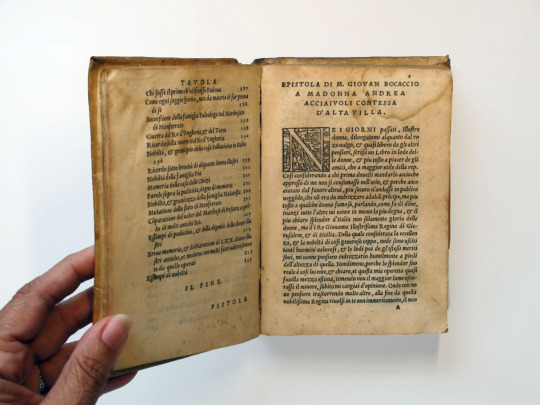


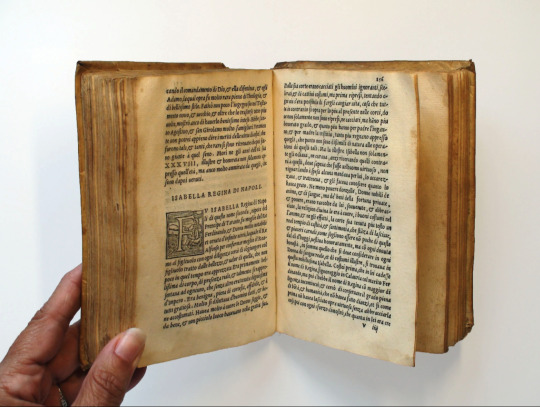
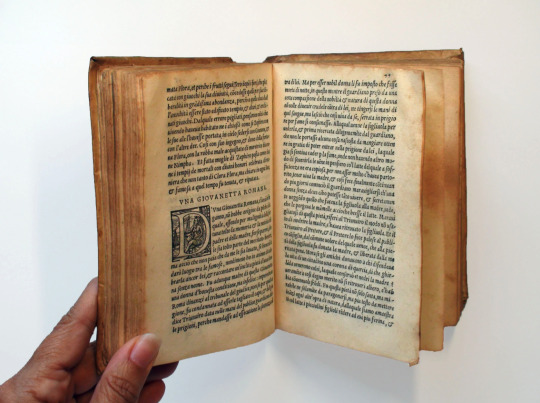
BUY IT NOW
Libro Di M. Gio Boccaccio Delle Donne Illustri
Tradotto Per Messer Giuseppe Betussi.
Con Una Additione Fatta,
Dal Medesimo Delle Donne Famose Dal Tipo Di M. Giovanni Fino à I Giorni Nostri
& Alcune Altre State Per Inanzi,
Con La Vita Del Boccaccio, & La Tavola Di Tutte L'historie, & Cose Principali
Che Nell'opra Si Contengono.
All'illustriss. S. Camilla Pallauicina Marchese Di Corte Maggiore.
In Vineggia M D LVIII
RARE, ITALIAN LANGUAGE
ILLUSTRATED
Publisher: Francesco e gli Imperatori, Veneggia (Venice)
Copyright: 1558
--ABOUT THIS ITEM--
Item Dimensions: 6.0 inches x 4.5 inches
Boccaccio's On Famous Women (De claris mulieribus) is a remarkable work that contains the lives of one hundred and six women in myth and history, ranging from Eve to Boccaccio's contemporary, Queen Giovanna I of Naples. It is the first collection of women's biographies ever written. Boccaccio composed it at Certaldo in 1361-62 and revised it in various stages to the end of his life in 1375. He dedicated it to Andrea Acciaiuoli, countess of Altavilla in the kingdom of Naples and sister of Niccolò Acciaiuoli, the grand seneschal of Queen Giovanna I.
In his preface, the author states that the biographies of illustrious men had been written often by a number of excellent writers, and he cited his hero Petrarch's Lives of Famous Men (De viris illustribus) as an example. No one, however, had ever done the same for women. Boccaccio, therefore, presents a wide variety of women from antiquity to his own time, offering their lives as both moral exemplar and entertaining reading. On Famous Women is the earliest source of women's biography in the West and has had a long and distinguished publication career and literary influence.
The famous women included are:
1. Eve, the first woman in the Bible
2. Semiramis, queen of the Assyrians
3. Opis, wife of Saturn
4. Juno, goddess of the Kingdoms
5. Ceres, goddess of the harvest and queen of Sicily
6. Minerva
7. Venus, queen of Cyprus
8. Isis, queen, and goddess of Egypt
9. Europa, queen of Crete
10. Libya, queen of Libya
11 and 12. Marpesia and Lampedo, queens of the Amazons
13. Thisbe, a Babylonian maiden
14. Hypermnestra, queen of the Argives and priestess of Juno
15. Niobe, queen of Thebes
16. Hypsipyle, queen of Lemnos
17. Medea, queen of Colchis
18. Arachne of Colophon
19 and 20. Orithyia and Antiope, queens of the Amazons
21. Erythraea or Heriphile, a Sibyl
22. Medusa, daughter of Phorcus
23. Iole, daughter of the king of the Aetolians
24. Deianira, wife of Hercules
25. Jocasta, queen of Thebes
26. Almathea or Deiphebe, a Sibyl
27. Nicostrata, or Carmenta, daughter of King Ionius
28. Procris, wife of Cephalus
29. Argia, wife of Polynices and daughter of King Adrastus
30. Manto, daughter of Tiresias
31. The wives of the Minyans
32. Penthesilea, queen of the Amazons
33. Polyxena, daughter of King Priam
34. Hecuba, queen of the Trojans
35. Cassandra, daughter of King Priam of Troy
36. Clytemnestra, queen of Mycenae
37. Helen of Troy, whose abduction by Paris began the Trojan War
38. Circe, daughter of the Sun
39. Camilla, queen of the Volscians
40. Penelope, wife of Ulysses
41. Lavinia, queen of Laurentum
42. Dido, or Elissa, queen of Carthage
43. Nicaula, queen of Ethiopia
44. Pamphile, daughter of Platea
45. Rhea Ilia, a Vestal Virgin
46. Gaia Cyrilla (Tanaquil), wife of King Tarquinius Priscus
47. Sappho, woman of Lesbos and poet
48. Lucretia, wife of Collatinus
49. Tamyris, queen of Scythia
50. Leaena, a courtesan
51. Athaliah, queen of Jerusalem
52. Cloelia, a Roman maiden
53. Hippo, a Greek woman
54. Megullia Dotata
55. Veturia, a Roman matron
56. Thamyris, daughter of Micon
57. Artemisia, queen of Caria
58. Verginia, virgin and daughter of Virginius
59. Eirene, daughter of Cratinus
60. Leontium
61. Olympias, queen of Macedonia
62. Claudia, a Vestal Virgin
63. Virginia, wife of Lucius Volumnius
64. Flora, goddess of flowers and wife of Zephyrus
65. A young Roman woman
66. Marcia, daughter of Varro
67. Sulpicia, wife of Quintus Fulvius Flaccus
68. Harmonia, daughter of Gelon, son of Hiero II of Syracuse
69. Busa of Canosa di Puglia
70. Sophonisba, queen of Numidia
71. Theoxena, daughter of Prince Herodicus
72. Berenice, queen of Cappadocia
73. The Wife of Orgiagon the Galatian
74. Tertia Aemilia, wife of the elder Africanus
75. Dripetrua, queen of Laodice
76. Sempronia, daughter of Gracchus
77. Claudia Quinta, a Roman woman
78. Hypsicratea, Queen of Pontus
79. Sempronia, a Roman Woman
80. The Wives of the Cimbrians
81. Julia, daughter of the dictator Julius Caesar
82. Portia, daughter of Cato Uticensis
83. Curia, wife of Quintus Lucretius
84. Hortensia, daughter of Quintus Hortensius
85. Sulpicia, wife of Cruscellio
86. Cornificia, a poet
87. Mariamme, queen of Judaea
88. Cleopatra, queen of Egypt
89. Antonia, daughter of Antony
90. Agrippina, wife of Germanicus
91. Paulina, a Roman woman
92. Agrippina, mother of the Emperor Nero
93. Epicharis, a freedwoman
94. Pompeia Paulina, wife of Seneca
95. Poppaea Sabina, wife of Nero
96. Triaria, wife of Lucius Vitellius
97. Proba, wife of Adelphus
98. Faustina Augusta
99. Symiamira, woman of Emesa
100. Zenobia, queen of Palmyra
101. Joan, an Englishwoman, and Pope
102. Irene, Empress of Constantinople
103. Gualdrada, a Florentine maiden
104. Constance, Empress of Rome and queen of Sicily
105. Camiola, a Sienese widow
106. Joanna, queen of Jerusalem and Sicily
#Camiola#Gualdrada#Zenobia#Empress Irene#Pompeia#Epicharis#Triaria#Cornificia#Claudia Quinta#Sophonisba#Berenice#Joanna of Jerusalem#Agrippina#Hypsicratea#Sempronia#Dripetrua#Curia#Paulina#Cleopatra#Cloelia#Circe#Tertia Aemilia#Theoxena#Boccaccio#giovanni boccaccio#On Famous Women#antiquarianbooks#antiquarian books#book#books
7 notes
·
View notes
Photo
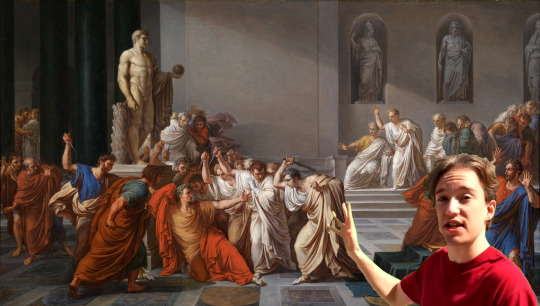
I am here at the Curia Pompeia
8K notes
·
View notes
Text
Love that the cover picture of the Wikipedia page for the Curia Pompeia is 3D model presumably ripped right out of a Roman Empire modpack for Myst:
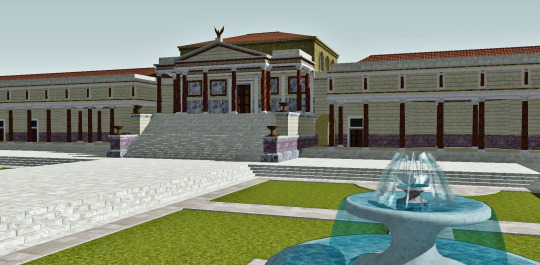
This is where Julius Caesar died spilling his voxel blood all over the bitmap and you can't change my mind.
74 notes
·
View notes
Text
trial of Sextus Cloelius
date: 52 BCE, after April 22
charge: lex Pompeia de vi (movement of Clodius’ body into curia)
defendant: Sex. Cloelius
advocate: T. Flacconius
prosecutors: M. Alfidius
C. Caesennius Philo
Asc. 55-56C
15 notes
·
View notes
Note
hi! can you please make a list of ancient roman inspired names, including some that are less common/not straight from mainstream mythology? thank you!
— 𝐀𝐍𝐂𝐈𝐄𝐍𝐓 𝐑𝐎𝐌𝐀𝐍 𝐍𝐀𝐌𝐄𝐒
below is a list of ANCIENT ROMAN inspired names. they are in alphabetical order, and split into 'masculine' and 'feminine' and 'unisex', for easier access. please LIKE / REBLOG if you find this list useful!
— 𝐌𝐀𝐒𝐂𝐔𝐋𝐈𝐍𝐄
Accius
Acilius
Acutius
Adiutor
Aedius
Aelianus / Aelius
Aemilianus / Aemilius
Aetius
Africanus / Afranius
Agathus
Agellus
Agricola
Agrippinus
Ahenobarbus
Akylas
Akylinos
Albanos / Albinianus / Albinius / Albinos
Alexinos / Alexinus
Amadias
Amicius / Amicus
Ampliatus
Ancus / Anicius
Annalis
Ansanus
Antoninos
Aphrikanos
Aquillius
Arrius
Arruns / Arruntius
Asper
Attius
Aufidius
Augoustinos / Augoustos
Augur
Aulos
Aurelianos / Aurelios
Aurius
Ausonius
Balbinos
Basolus
Bassianus
Bibulus
Blaesus
Blossius
Bonus
Britannicus
Broutos / Brutus
Caesarion
Calpurnianus
Caninius / Canius
Capito / Capitolinus
Cartilius
Carus
Carvilius
Casca
Castricius
Castus
Catullus
Caudex
Ceionius
Cicerón
Cincinnatus
Cinna
Clateus
Clodius / Cordius
Corellius
Coriolanus
Cornificius
Coropas
Corvus
Cossus / Crassus
Curius / Curtius
Dacianus / Dacius
Damasippus
Damasius
Datius
Decius
Defendens
Dentatus
Diaulus
Diocletius
Dolabella
Drousos / Drusianus
Equitius
Eulalus
Eumachius
Favian / Favonius
Martinos / Martius
Marullus
Maternus / Maturinus
Maxentios / Maximinos
Memmius
Messala
Metellus
Mettius
Minatus
Minervinus / Minervius
Miniatus
Minius
Montanus
Mucius
Munatius
Natalis
Naucratius
Necessitus
Nerius
Neron
Neroua
Nervas
Noma
Novatus / Novius
Numerius
Nymphias
Opimius
Opiter / Opiternius
Oppius
Optimus
Orestinus
Ostorius
Oualentinianos / Oualentinos / Oualerianos / Oualerios
Ouespasianos
Ouiktor
Oursos
Ovius
Paccius
Patrobas
Paulinos / Paullus
Pergentinus
Pertinax
Phabianos / Phabios / Phabrikios
Phaustinos / Phaustos
Phillipus
Phloros
Phourios
Pictor
Plautus
Pompo
Pontios
Poplios
Poppaeus
Portian / Portius
Poublios
Priscillus
Priskos
Probus
Processus
Proculus
Propertius
Pupillus
Quartus
Quintianus
Quiricus
Radix
Regoulos
Romanicus
Romulan / Romulanus
Roscius / Rosius
Rouphinos / Rouphos
Rullianus / Rullius / Rullus
Rupilius
Russus
Rutilius
Sabinos
Salinator
Sallustius
Satorninos / Satourninos
Savinus
Sawiris
Scaurus
Scribonius / Scribonus
Sedulius
Sekoundos
Sempronius
Senekas
Seouerianos / Seouerinos / Seoueros
Seppius
Serenos / Serenus
Sergios
Serouios
Sertor
Servilianus / Servilius
Servios
Severianos / Severinos / Severos
Silius
Sosius
Sporus / Spourios
Statilius
Statius
Sulpicius
Surdinius / Surdinus
Symphorus
Tarkynios
Tenagino
Terentios
Thrax
Tiberinus
Tibullus
Titinius / Titius
Torquatus
Toullios
Trebius
Turpilius
Ulpian
Ummidius
Valentinianos / Valentinos / Valerianos / Valerios
Varro / Varus
Venustian / Venustianus
Verus
Vespasius
Vettius
Vicesimus
Vinitius
Vipsanius
Viridianus / Viridius
Volesus / Volsus
— 𝐅𝐄𝐌𝐈𝐍𝐈𝐍𝐄
Accia
Aconia
Acutia
Adelphasium
Aedia
Afrania / Africana
Aimilia
Akylina
Albinia
Amica
Anicia
Aniensis
Annia
Appia
Aquilia
Arria
Arruntia
Atia
Aufidia
Aula
Aureola
Auria
Avidia / Avita
Blanda
Caenis
Caesillia / Caesula
Caia
Caietana
Capitolina
Cartilia
Carvilia
Cassiana
Castricia
Ceionia
Cordia
Corellia
Cornificia
Crispina
Curia
Cypriana
Dacia
Domitiana
Drusiana
Eumachia
Felicula
Ferocia / Ferocilla / Ferocina
Floridia / Floridiana
Furia
Furnia / Furnilla
Fusca
Fuscinilla
Hostilia
Iaia
Ianouaria
Invidia
Ioulia / Iouliana
Ioulitta
Iuventas
Januaria
Joviana
Kaikilia
Kouinta
Lepida
Licinia
Livilla
Lollia
Loukilla
Loukretia
Lucillia
Luciola
Maecia
Mamerca
Mania
Materna
Maxentia
Maximiana / Maximina
Mercuria
Messalina
Metella
Mettia
Milonia
Mucia
Munatia
Naevia
Necessitas
Neruia
Novia
Octaviana
Opimia
Oppia
Orestilla
Orestina
Oualentina
Oualeria / Oualeriana
Phabia / Phabiana
Phausta / Phaustina
Pompeia / Pompilia
Poppaea
Potita / Potitia
Procula
Pulchra
Quadratilla
Quarta / Quartilla
Quieta
Quinta / Quintia / Quintiana
Quintilia / Quintiliana
Romilia / Romula
Roscia / Rosia
Rupilia
Rutilia
Sagitta
Sallustia
Saturna
Scaura
Scribonia
Sebine
Secunda / Secundilla
Sedulia
Semperbella
Sempronia
Seouera
Sertora
Servilia
Severa / Severiana / Severilla
Statilia
Stellatina
Sulpicia
Surdinia
Sympherusa
Symphora
Tatia
Terentia
Tiberia
Tita / Titia / Titinia
Tuccia
Turia
Ulpia
Ultima
Vipsania
Viridia / Viridiana
Vistilia / Vitalina
Vitellia
Volesa / Volusa / Volusia
— 𝐔𝐍𝐈𝐒𝐄𝐗
Agrippa
Aquila
Glaucia
Iovita
Merula
146 notes
·
View notes
Text
So ironic of us to choose Curia Pompeia for the assassination of Caesar. Yeah boy, love being reminded of my greatest political enemy on my deathbed!
9 notes
·
View notes
Text
On the Steps of the Curia Pompeia - M - 1.6k - Marvel 616
Archive Warning: Major Character Death
Relationships: Tony Stark/Tiberius Stone
Tags: Alternate Universe - Ancient Rome, mildly graphic depictions of violence, lots and lots of blood, Lovers To Enemies, to lovers again to enemies again, to lovers AND enemies, to guy with knife and corpse
Antonius had planned for a clean kill. It was for the sake of Rome. It was— It was to prevent Rome from falling prey to another king, it was for no one and nothing else.
It was for no one and nothing else.
Antonius twisted the blade, and he reveled in the choked “ah,” that fell from Tiberius’ lips.
Also known as: I wrote a Rome murder snippet of a fic I'll probably never complete, so please enjoy the tiny nibble of it!
5 notes
·
View notes
Text
THE THEATRE OF POMPEY, Pt. 1

Pompey the Great began to build the first permanent theatre in Rome over the years c. 61/55 BC. The construction of the immense theatre coincided with the first triumvirate, the renewal of which at Lucca in 56 BC paved the way for Pompey’s second consulship, with Crassus, in 55 BC and his governorship of Spain.

Almost every aspect of the building--its location, form, scale, function--was determined by political considerations. Pompey himself conceived of the theatre as an never-ending triumph, perpetuating the memory of his brilliant career, as a venue for his political activities, and as a sign of his taste and admiration of Hellenic culture. First and foremost, however, he conceived of the building as a massive bribe designed to buy the support to the common people at a critical moment in a high-stakes power struggle.

The vast complex had a long-term significance as well. It transformed the course of Roman architecture, serving as the architectural model for subsequent theatres and as the patronage model for the large-scale, public commissions undertaken by the emperors.
The theatre of Pompey was an amalgamation of buildings with varied and sometimes interrelated functions. The theatre, or entertainment portion, was modeled on the Hellenistic theatre at Mytilene, which Pompey visited in 62 BC, but executed on a much larger scale. The three-story, 90 meter-wide scenae frons was able to accommodate 600 donkeys trotted on stage simultaneously during the performance of play. Pliny estimated the seating capacity at 40,000, which was dismissed for centuries as exaggeration, but has been confirmed by recent excavations.
As the donkeys suggest, a theatre of this size could accommodate a wider range of entertainments than the typical Greek theatre. Cicero’s account of the open days of the theatre mentions not only recherché Latin and Oscan dramas and dramatic readings by famous retired actors, but athletic competitions and gladiatorial combats as well (venationes several days in length were carried out in the nearby Circus Flaminius). Like the amphiteatre of Pompeii, Pompey’s cavea was shaded by a velarium; The cavea was also cooled by water flowing through channels cut into the stone floor.

The religious component, a small temple of Venus Victrix, to whom Pompey attributed his victories, was placed at the top of the cavea, which served as the temple’s podium and staircase. This arrangement was not unprecedented: the hemicycle temple at the summit of the sanctuary of Fortuna Primagenia in Praeneste (seen below) was approached by a semi-circular staircase which doubled as theatre seating. The temple was completed three years after the opening of the theatre. Several smaller shrines dedicated to Virtue, Felicitas, and Honor were located in the theatre.

Abutting the back of the scenae frons was an immense porticus pone scaenam, the building’s social component. Pompey’s porticus differed considerably from the practical storage facility and shelter later codified by Vitruvius. The Severan Forma Urbis indicates a vast, enclosed, peristyle garden, planted with rows of plane trees interspersed with fountains and pedestal statuary chosen by Titus Pompilius Atticus (which may have included the 6-meter gilded bronze statue of Hercules discovered during excavations in 1865). Additional amenities included a gallery, dedicated to the display of Pompey’s war spoils. The garden quickly became a popular meeting place and a prototype for numerous enclosed parks in Rome. The two long covered pavilions seen in Gismondi’s plastico are not supported by archæological evidence.
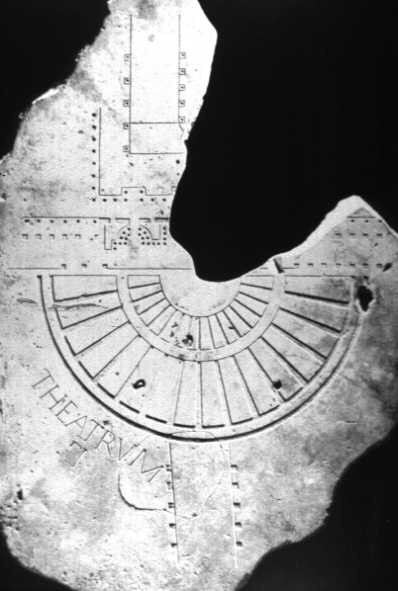

Finally, a curia, or meeting place for the senate, the building’s political component, was built into an exedra at the eastern end of the porticus. It was in the curia pompeia, and not the curia hostilia in the Roman Forum, that Julius Caesar was assassinated in 44 BC. Jean-Léon Gérôme’s painting of Caesar’s assassins (1859/67) recreates the curia as it was understood by 19th-century archæology.
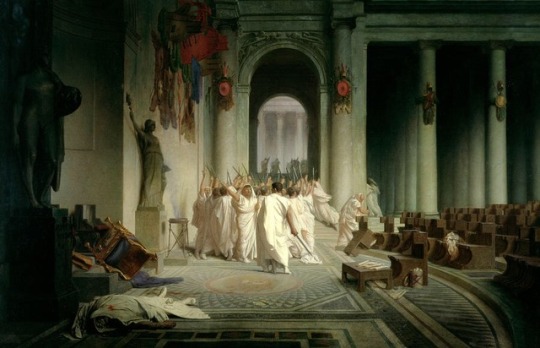
The walls of the theatre and portico were composed of traditional travertine masonry, while the innovative system of vaults and arches that supported the cavea were composed of concrete. The red granite engaged columns and blind arches that made up the three tiers of arcades of the exterior elevation were purely decorative, serving no supporting function. The use of a concrete substructure to support the cavea made it possible for Pompey to choose a location on flat land in the center of Rome.

Covering what s now an entire neighborhood, the theatre of Pompey extended from the Campo de’ Fiori to the Largo Argentina area sacra—a distance of approximately 500 meters. The Flavian Amphitheatre, by contrast, is 189 meters in length. If it were still standing, the theatre would tower over every other structure in the vicinity, including the church of Sant’ Andrea della Valle. The first theatrum lapideum in Rome was the largest theatre ever built in antiquity and the most impressive public building in the city, surpassed in scale only by the Domus Aurea in the next century.
1. Italo Gimondi, Topographical Map of Ancient Rome, Rome, Museo della Civiltà Romana.
2. Victoire Baltard, Section of Theatre of Pompey Cavea,
3. 3D Rendering of the cavea.
4. Reconstruction drawing of the cavea and temple.
5. 3D rendering of the temple of Fortuna at the Sanctuary of Fortuna Primagenia, Praeneste.
6. Severan Forma Urbis, c. AD 205, Rome, Archivio Storico Capitolino.
7. Rodolfo Lanciani, Forma Urbis Romae, Pl. XXI, 1893/1901.
8. Jean-Léon Gérôme, Assassination of Julius Caesar, 1859/67, Baltimore, Walters Art Gallery.
9. Reconstruction drawing, 1915.
10. Google Earth view of area of modern Rome where the theatre was located.

#roman architecture#gnaeus pompeius magnus#porticus pompeianae#roman gardens#julius caesar#classical antiquity#mytilene#rodolfo lanciani
6 notes
·
View notes
Text
If Pompey is an electric eel he can make lightning! Note also that Pompey is, like, a god in JC because curia Pompeia is his temple and he is sacrificed to there. I'm not saying nor I want to say he's Jupiteel (Jupiter eel), but make what you will of it.
0 notes
Text
RT @cesarfuri: Con motivo de los recientes #IdusDeMarzo, vamos a realizar un hilo acerca del lugar del deceso, la Curia Pompeia, en clave religiosa ⤵️⤵️⤵️ (📸: Curia Pompeia con evidencia de los muros en opus reticulatum según G. Gatti y G. Marchetti Longhi, 1957) https://t.co/SnkNEamA0X
Con motivo de los recientes #IdusDeMarzo, vamos a realizar un hilo acerca del lugar del deceso, la Curia Pompeia, en clave religiosa ⤵️⤵️⤵️
(📸: Curia Pompeia con evidencia de los muros en opus reticulatum según G. Gatti y G. Marchetti Longhi, 1957) pic.twitter.com/SnkNEamA0X
— Caesar: Drama, Legend, History (@cesarfuri) March 16, 2019
via Twitter https://twitter.com/Lomonpla
March 16, 2019 at 12:10PM
0 notes
Note
32, 33, 40
32. What story do you think showcases your signature style the most?
Oh, goodness, I don't know. The funny thing about that is that I think I kind of need Ty, Tony, and Steve to flex a full range of what I see as core aspects of my writing-- not necessarily this trio exactly, but this kind of trio, and I don't currently have any stories (cough cough on ao3 cough cough) that fully execute that the way I think I'd want it to be executed for the sake of showing my "signature style."
That being said, I think that has more to do with my own self-assessment of what's important to me in my writing; other people might come away from reading my fics and think that my "signature style" is something different than what I tend to think of it as.
Out of the works I do have up, I kind of think On the Steps of the Curia Pompeia might actually be the closest thing to what I'd write if you just handed me a laptop and said "Go!"
33. Have you ever stopped yourself from writing something? Why?
Well, antis and vulnerability, honestly. There was a point in time at which it was like, legitimate fear and guilt 100% of the time--like, I actually thought I was doing something wrong and actually believed people were entitled to my Life Experience Credentials in order for me to justify content that barely scratched the surface of what I felt I needed to write in order to be satisfied. And, like, guilt is still difficult to escape at times just because of how guilt as a default state can work, but mostly I just can't be bothered to deal with people now.
I mean, that potential Ty redemption arc I mentioned was one of those ideas I'd had for a long, long while before ever feeling okay enough with it to even casually mention, given that abuse is the one thing I tend to write about most and, as such, what I've received the most, er... let's say feedback on. So, it's largely a matter of conditioning, too; I assume automatically that some works, despite being less likely to be seen, would be more likely to get criticism if they were seen, and whether or not it matters enough to me to deal with the potential internet ramifications of that varies from day to day and fic to fic.
I do talk more shamelessly about that these days, though, especially since accidentally building a brand on Tony's only semi-canonical, very shitty (human) boyfriend. (Y'know, as opposed to the robot one.) I figure everyone who finds that distasteful is probably gone by now, and only a few stragglers pass by every so often.
Be nice, I guess, if you want to take anything away from this. But it's not like nobody knew that to begin with.
40. What area of writing do you want to improve in?
I know this is kind of memed, but the area I'd like to improve in most is just, like, actually writing. For many reasons, I can forgive myself for not being the most disciplined or consistent writer-- and frankly, I don't think anyone should be unable to forgive themselves for that-- but it would still be nice if I were able to create stuff consistently. It's usually better for me to be creating things than it is to not be creating things.
In terms of actual execution, though, I don't actually know what I'd want to improve in-- it's not that I love my writing all the time, I just feel like everything I'd like to be making progress on seriously, I've been pretty consistently improving, like defining genres and plotting/executing well-paced long stories. I could maybe benefit from writing more smut, though. 😛
5 notes
·
View notes
Text
fic writer meme :)
i was tagged by @dirigibleplumbing <3
1. How many works do you have on AO3?
17 right now! I'm pretty sure my highest ever was in the 90s, pre-Cass purge.
2. What’s your total AO3 word count?
63,334.
3. What are your top 5 fics by kudos?
Work of Art, No Embellishments, Last (Another) Day, Love (Actually), and First Impression. Quite the genre mix. ^^
4. Do you respond to comments? Why or why not?
I try to, and I definitely do within the first few days of posting something, but sometimes comments can be difficult to respond to without regurgitating the same "Thank you!" over and over again, even though it's definitely heartfelt. There's usually an amount of time after posting that I mostly stop responding to comments unless one touches me deeply.
5. What’s the fic you’ve written with the angstiest ending?
Maaybe Disjointed, which starts in misery and ends in misery and definitely has more build-up and less hope than most other angst I've written. That being said, On the Steps of the Curia Pompeia is straight up just a brutal gay murder where Tony is in agony the whole time.
6. What’s the fic you’ve written with the happiest ending?
I have some fluffy-ish oneshots that I think could qualify, but they're too short to really have solid "endings" or parts with separate and distinct moods, so... probably First Impression. It's a silly little get-together.
7. Do you write crossovers? If so what’s the craziest one you’ve written?
Nope! I'm not opposed to it, though.
8. Have you ever received hate on a fic?
Yep!
9. Do you write smut? If so what kind?
Yep! It's mostly the "pretty men are in agony because life and fuck instead of talking" kind.
10. Have you ever had a fic stolen?
Not a fanfic, but definitely writing.
11. Have you ever had a fic translated?
I don't think so, but I also don't have a great memory with these kinds of things.
12. Have you ever co-written a fic before?
Yep! Many moons ago.
13. What’s your all time favorite ship?
Anyone who knows me knows that "favorite" is a word I have conflict with often, but my big two are Stony and Ty/Tony.
14. What’s a WIP that you want to finish but don’t think you ever will?
Whatever it is, I probably don't even remember it. One of the many Ty scribblings, I think.
15. What are your writing strengths?
I like my tone-setting and my diction; it's not necessarily a "writing" thing exclusively so much as it is an internal monologue + speaking thing that bleeds into my writing. I did pretty intentionally curate my vocabulary and manner of speaking so that it would sound pleasing to me personally, with little regard for how it came across. One of the funnier things that I picked up was using outdated language like "[something] of yore" and "egads" and "over yonder" and whatnot, and the reason it was funny was because I was a child when I chose to do this (all of my teachers loved me, you can imagine). I'm no longer a child, but I still talk like this, and it's not nearly as funny. I'm really dealing with the consequences of my actions here as a once-wannabe-court-jester.
... But, y'know, it's me, and I still like it. And, hey, at least baby me grew out of "mehercule!"
16. What are your writing weaknesses?
I'm terribly melodramatic (in case you couldn't tell) and undisciplined, and I don't like killing my darlings because I don't want them to fall into the abyss of forgotten memories.
17. What are your thoughts on writing dialogue in other languages in a fic?
There are plenty of ways of doing it and they certainly all have their pros and cons, I think. I really love the comic book-y style of "<insert dialogue here>" (*translated from [Language]!), but this can get a bit clunky when a fic is written like a book without other comic book-like elements.
My preference in most writing, just because it's what I'm used to, is introducing the foreign words and then having translations at the end in an author's note. I'm currently writing a Filipino Tony fic and that's what I'll probably end up using.
18. What was the first fandom you wrote for?
No clue. It was a while back and my memory's shit. The earliest fic I can confidently remember (even though I know for a fact this is still, like, maybe 5 years after I started writing fanfic) was for Durarara!! I still hold DRRR!! very dear in my heart.
19. What’s a fandom/ship you haven’t written for yet but want to?
I'm planning on writing a Critical Role Campaign 3 fic for a friend of mine.
Aaand I'd like to write Ty Stone/Carol Danvers at some point, because my lovely girlfriend and I stumbled across the concept of them as a dynamic and it tickled me.
20. What’s your favorite fic you’ve written?
Once again, terrible at favorites. I still am proud of Disjointed, just because it was the first horror piece I'd ever finished all the way through and I think it's far more functional than I expected it to be. I'm also proud of On the Steps, just because of how gloriously self-indulgent it was.
If this includes unpublished fics, though, I'm reworking Sympathy for the Devil (the big Ty fic) right now and I really do love it. It's kind of a canon rewrite that really sets the tone for a Tiberius storyline that would be the most meaningful to me (kind of, ish). I'm planning many different Ty fics with many different characterizations (from "actually not the worst dude" to "has never felt love or empathy or kindness in his life"), but SFTD is what I hope I can point to as my Favorite Ty.
-
i'm pretty sure everyone i love has been tagged on this post before so if this is a double tag then whoops! @welcomingdisaster @kiyaar @oluka @starvels @laexploradoraaa
5 notes
·
View notes
Note
🤍
Edit: I am very silly and did not realize that the red and white hearts were different questions. Will be responding to this in a separate post. Whoops!
Here's the unedited answer, where I answered the question I thought was asked:
💘 - Favourite line from a fic/hc I’ve finished?
The following excerpt is from On the Steps of the Curia Pompeia, which I actually ended up loving a lot in a way I don't usually love my fics. Knowing it's targeted toward kind of a niche demographic, I am grateful for the chance to share this little excerpt that I enjoy:
On the steps of the Curia Pompeia, reality took place. Reality scattered with the hard-beating hearts of the murderers who enacted it. A fragment of it ended with Brutus’ taking of his own life, another forcefully cut from the world as Trebonius’ head was from his neck. Bit by bit, reality faded back into play.
The last remaining piece of it hid for 14 long, haunting years under the cloak of Cassius Parmanesis.
And then it was over.
Brute, Antonius’ mind taunted him.
Aaand here's one from a fic called Disjointed, a psychological horror fic for kiyaar for the YGMAH holiday stockings. I also love this one in a way I don't usually love my fics-- I think there's something about fics that really, really need a specific mood to be set that just get my brain going.
It was easy to recall the “games” he’d play with the mansion when he was younger. Though the thrum of its inner machinations (of which it had many, being a Stark house) brought comfort to him then, he remembered a time when it seemed almost eerie, as if the whole place were alive and breathing. In the winter, especially, on some of the coldest nights Tony had ever lived through, the mere exhale of the mansion’s whole being as the vents warmed made him feel hollow inside, almost to the point where he’d prefer to stay cold.
1 note
·
View note
Text
THE THEATRE OF POMPEY, Pt 2
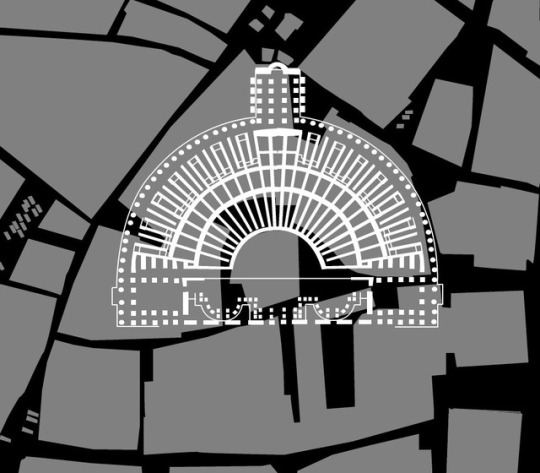
The Theatre of Pompey was the first permanent theatrum lapideum in Rome, but not in Italy. During the Samnite period, a large concrete and stone theatre had been built in Pompeii and a second smaller odeon was built after the Roman annexation. In the capitol, however, permanent theatres were proscribed, due to the republic's long-standing doubts about their morality.

In 155 BC, acting on the motion of the consul Scipio Nasica, the senate ordered the demolition of a stone theatre nearing construction in Rome. Velleius Paterculus ascribes this decision to “the exceptional austerity (severitas) of character of the populace" at that time. A new law was also passed, banning seating in temporary wooden theatres erected for religious festivals within the pomerium. According to Valerius Maximus, the new law aimed to protect Roman virilitas, which was fortified by standing and would be diminished by sitting down. This notion was still current two centuries later, when Tacitus condemned the idea of sitting during a theatrical performance as another deplorable Greek habit that would corrupt the morals of Roman youth.

Pompey urgently needed to complete the theatre quickly in order to benefit from the anticipated public support it would engender before he stood for consul again. The senatorial ban was the only real impediment. Tertullian states that Pompey added the Temple of Venus Victrix to the theatre in order to define the building as a temple with a cavea-shaped staircase, and thus skirt the ban on permanent theatres. This semantic ploy allowed the senate to save face while acquiescing to an complete reversal of a long-held policy and avoid a direct confrontation with Pompey. Following the official cues, most Roman writers referred to he building as a temple. The label on the Severan forma urbis, however, emphatically reads THEATRUM.

The seating ban was neutralized by locating Pompeys’s theatre on the Campus Martius, which lay outside the pomerium. There were probably more compelling reasons than respect for the seating ban that motivated Pompey’s choice of locations. Building within the pomerium imposed restrictions: provincial promagistrates and generals lost their imperium, soldiers were immediately demobilized and returned to civilian status, and weapons prohibited in the pomerium. On the other hand, the curia pompeia’s location allowed senators who were proscribed from entering the pomerium to participate in senate business. As a general and the provincial governor who had attained his position of power by military force, Pompey was unlikely to have built a theatre in a zone that would have automatically neutralized his sources of power should he enter it. Thus one can assume that Pompey always intended the build outside the pomerium and that the only real obstacle his project faced was the ban on permanence.
During the senate debate in 155, Scipio Nasaica cited a non-moral reason for banning theatres. Large assemblies of citizens could easily be incited to acts of seditious. This anxiety proved prescient: Pompey had planned to use his theatre as a venue for addressing the public directly, without senatorial interference. Fear the this type of subversive use of a theatre had caused the senate to make the drastic decision to destroy the theatre in 155 BC. There was no thought of resisting Pompey 100 years later.
Pompey’s concluded his architectural campaign to reduce the senate by building the curia in the porticus. Having the senate meet in a building he owned sent a clear message to the Roman world that a new political order was coming into being. The face of the new order, however was neither Pompey, who was assassinated in 48 BC nor his rival, Julius Caesar, who met the same fate in the curia pompeia four years later.
The Theatre of Pompey was considered the principal theatre in Rome and meticulously maintained for centuries. Recognizing its propagandistic value, Augustus and Tiberius carried out extensive renovations. The emperors entertained foreign dignitaries there, who were duly awestruck. Pliny the Elder notes that Nero “covered the theatre of Pompey with gold for one day’s purpose, when he was to display it to Tiridates King of Armenia.”
The theatre outlived the western empire. The Romanized Goths renovated the structure thoroughly for the last time in the early 6th century. As the city’s population declined, it fell into disrepair. Like the Colosseum, it served as a quarry in the dark ages, but enough of the concrete substructure survived for the site to be identified as a theatre in the 12thc. pilgrim's guide to Rome. Much of the marble revetment facing the Cancelleria was taken from the site in the 15th century.
Although virtually nothing of the edifice survives above ground today, its presence is still immediately registered by curvature of Via della Grotta Pinta the Orsini palace that was built on top of its ruins.
#gnaeus pompeius magnus#ancient theatres#roman architecture#concrete#mytilene#porticus#cavea#pomerium#classical antiquity
3 notes
·
View notes